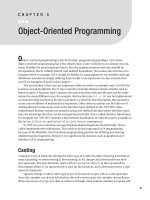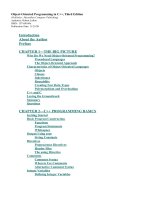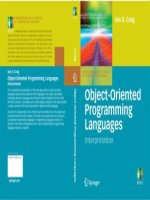Lecture Object oriented programming - Lecture No 27
Bạn đang xem bản rút gọn của tài liệu. Xem và tải ngay bản đầy đủ của tài liệu tại đây (168.36 KB, 17 trang )
CSC241: Object Oriented Programming
Lecture No 27
1
Previous Lecture
•
•
Functional templates
–
Example program
–
multiple arguments
–
Macros vs. template
Class templates
–
Stack template class
–
Default and non type parameter for class template
–
Explicit specialization
2
Today’s Lecture
•
Exception
•
Exception handling
•
try , catch and throw block
•
Multiple exceptions
3
Exceptions
•
•
•
Exceptions are errors that occur at runtime
Exception handling provide a systematic,
object-oriented approach to handling errors
generated by C++ classes
For example,
–
running out of memory,
–
not being able to open a file,
–
trying to initialize an object to an impossible value,
–
or using an out-of-bounds index
4
Why Do We Need Exception handling
•
•
C-language programs signal an error by
returning a value from the function
For example, disk-file functions often return
NULL or 0 to signal an error
if( somefunc() ==
ERROR_RETURN_VALUE )
//handle the error
else
//proceed normally
if( anotherfunc() ==
if( thirdfunc() == 0 )
NULL )
//handle the error
//handle the error
else
else
//proceed normally
//proceed normally
5
Cont.
•
Problem : Every single call to such a function
must be examined by the program
–
•
if else block and writing statement to handle error
requires more code and make file size larger
More complex problem: classes are used,
–
errors may take place without a function being
explicitly called
SomeClass obj1, obj2, obj3;
–
How application know if there is error in constructor
6
Exception syntax
•
•
•
•
•
Imagine an application that creates and interacts
with objects of a class
Usually the application’s calls to the class
member functions cause no problems
Sometimes, the application makes a mistake,
causing an error to be detected in a member
function
This member function informs the application
that an error has occurred
When exceptions are used, this is called
throwing an exception.
7
Cont.
•
A separate section of code to handle the errors
is called exception handler or catch block
–
•
•
•
•
catch block catches the exceptions thrown by the
member function
In program the code uses objects of the class is
enclosed in a try block.
Errors generated in the try block will be caught
in the catch block.
Code that doesn’t interact with the class need
not be in a try block
The exception mechanism uses three new C++
8
The exception mechanism
9
class Aclass {
public:
class AnError //exception class
{ };
void Func() {
if( /* error condition */ ) 2
throw AnError();
}
};
main() {
try {
1
AClass obj1;
obj1.Func();
}
catch(AClass::AnError) {
3
//tell user about error
}
}
Program
skeleton
If error occur in
Func() an
exception is
thrown
try block contain
the code that may
cause exception
When exception
is thrown control
is tranfer to catch
block
10
class Stack {
private:
int st[3];
int top;
public:
class Range { };
Stack() { top = -1; }
void push(int var) {
if(top >= 3-1)
throw Range();
st[++top] = var;
}
int pop() {
if(top < 0)
throw Range();
return st[top--];
}
Simple example – Stack
main() {
Stack s1;
try {
s1.push(11); s1.push(22);
s1.push(33); s1.push(44);
cout << "1: " << s1.pop() << endl;
cout << "2: " << s1.pop() << endl;
cout << "3: " << s1.pop() << endl;
cout << "4: " << s1.pop() << endl;
}
catch(Stack::Range) {
cout << "Exception: Stack Full or
Empty";
}
Go to
cout << "Arrive here";
program11
}
Specifying the Exception Class
class Range {
//note: empty class body
};
•
•
Body of the class is empty, so objects of this
class have no data and no member functions
Simple example require class name Range to
connect a throw statement with a catch block
throw Range();
•
•
It will create an object of Range class
Transfer the control to exception handler
12
Exception Handler (Catch Block)
Exception class name
catch(Stack::Range) {
//code that handles the
exception
}
•
•
exception class name must include the class in
which it is located
It must immediately follow by try block
13
Sequence of Events
1.
Code is executing normally outside a try block.
2.
Control enters the try block.
3.
4.
5.
If a statement in the try block causes an error in
a member function.
Then member function throws an exception.
Control transfers to the exception handler
(catch block) following the try block
14
Multiple exceptions
•
•
•
Stack class only throw one exception in both
cases, either stack is empty or full
It can be modified to throw an any number of
exceptions
Stack class can be modify to throw separate
exceptions for attempting to
•
•
push data on a full stack and
attempting to pop data from an empty
stack.
15
class Stack {
private:
int st[3]; int top;
public:
class Full { };
class Empty { };
Stack() { top = -1; }
void push(int var) {
if(top >= 3-1)
throw Full();
st[++top] = var;
}
int pop() {
if(top < 0)
throw Empty();
return st[top--];
}
Multiple exceptions
main() {
Stack s1;
try {
s1.push(11); s1.push(22);
s1.push(33); s1.push(44);
cout << "1: " << s1.pop() << endl;
cout << "2: " << s1.pop() << endl;
cout << "3: " << s1.pop() << endl;
cout << "4: " << s1.pop() << endl;
}
catch(Stack::Full) {
cout << "Exception: Stack Full";
}
catch(Stack::Empty) {
cout << "Exception: Stack Empty";
}
Go to
}
program16
Note
•
•
•
A separate catch block is used for each
exception
Only one catch block is activated for a given
exception
A group of catch blocks, or a catch ladder is
executed a little like a switch statement
17









